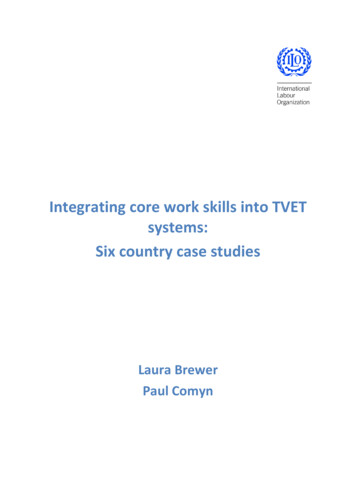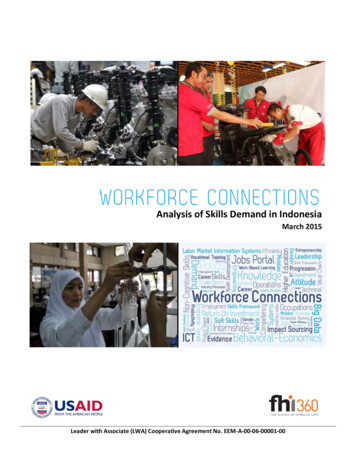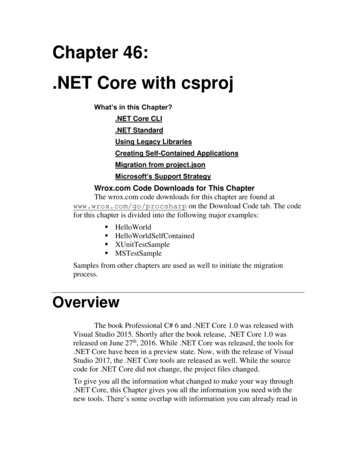
Transcription
Integrating core work skills into TVETsystems:Six country case studiesLaura BrewerPaul Comyn
Copyright International Labour Organization 2015First published (2015)Publications of the International Labour Office enjoy copyright under Protocol 2 of the Universal CopyrightConvention. Nevertheless, short excerpts from them may be reproduced without authorization, on condition thatthe source is indicated. For rights of reproduction or translation, application should be made to ILO Publications(Rights and Licensing), International Labour Office, CH-1211 Geneva 22, Switzerland, or by email:rights@ilo.org. The International Labour Office welcomes such applications.Libraries, institutions and other users registered with a reproduction rights organization may make copies inaccordance with the licences issued to them for this purpose. Visit www.ifrro.org to find the reproduction rightsorganization in your country.ILO Cataloguing in Publication DataBrewer, Laura; Comyn PaulIntegrating core work skills into TVET systems : six country case studies / Laura Brewer, Paul Comyn ;International Labour Office, Skills and Employability Branch, Employment Policy Department. - Geneva: ILO,2015ISBN: 9789221305385 (print); 9789221305392 (web pdf)International Labour Office. Employment Policy Dept.basic skill / transferable skill / vocational training / employability / case study / Australia / Chile / India /Jamaica / Malawi / Philippines13.02.2The designations employed in ILO publications, which are in conformity with United Nations practice, and thepresentation of material therein do not imply the expression of any opinion whatsoever on the part of theInternational Labour Office concerning the legal status of any country, area or territory or of its authorities, orconcerning the delimitation of its frontiers.The responsibility for opinions expressed in signed articles, studies and other contributions rests solely withtheir authors, and publication does not constitute an endorsement by the International Labour Office of theopinions expressed in them.Reference to names of firms and commercial products and processes does not imply their endorsement by theInternational Labour Office, and any failure to mention a particular firm, commercial product or process is not asign of disapproval.ILO publications and digital products can be obtained through major booksellers and digital distributionplatforms, or ordered directly from ilo@turpin-distribution.com. For more information, visit our website:www.ilo.org/publns or contact ilopubs@ilo.org.Printed in New Delhi.ii
ForewordCountries across the world are looking to implement strategies that improve both the employmentprospects of young women and men and the productivity of enterprises. Central to both theseoutcomes is a solid foundation of core skills as a major contributor to employability, along withaccess to education, availability of training opportunities, and the motivation, ability and support totake advantage of opportunities for continuous learning.In 2013 the ILO prepared the Guide to core work skills to help key stakeholders better understandwhat core work skills are, their importance, and ways in which these skills can be delivered, attainedand recognized. While a considerable literature exists on how to address core skills through theeducational curriculum, there is less material available to guide policy-makers on how to integratecore skills into education and training systems. This paper seeks to fill this gap.While most attention has hitherto been given to general education systems, technical and vocationaleducation and training (TVET) and skills development have equally central roles to play in thedevelopment of core skills for employability. Quality, demand-driven TVET and skills development,both in and out of school, are potentially among the most important tools for equipping young peoplewith the skills they will need. Consequently, core skills are assuming increased importance andsignificance in the TVET and skills sectors.This report assesses the extent to which six diverse countries have embedded core skills foremployability in their TVET and skills systems: Australia; Chile; India; Jamaica; Malawi; and thePhilippines. These six case studies have demonstrated that in both developed and developingcountries, much remains to be done to ensure that TVET and skills systems adequately andsystematically take steps to develop the core skills that so profoundly enhance the employability oflearners, jobseekers and workers.We are grateful to Laura Brewer, Specialist in Skills for Youth Employment (ILO Geneva) and PaulComyn, Specialist in Vocational Training and Skills Development (ILO New Delhi) for undertakingthis research. We would also like to thank the consultants who prepared the case studies: AndreaBateman (Australia), Marcela Arellano Ogaz (Chile) Anand Shukla (India), Paul Payne (Jamaica),Jones Chafa (Malawi) and TESDA under the supervision of Irene Isaac (Philippines). Colleagues inthe field and HQ also provided invaluable direction. We particularly acknowledge Hassan Ndahi,Ashwani Aggarwal, Fernando Vargas, Akiko Sakamoto and Amy Torres for quality control of thecountry studies in their respective regions. The financial support received from the Japanesegovernment under the ILO/Japan Regional Skills Programme which funded the two Asian casestudies is much appreciated.Girma AguneActing ChiefSkills and Employability BranchILO GenevaPanudda BoonpalaDirectorDecent Work Team for South AsiaILO New Delhiiii
iv
Table of contentsForeword . iiiAcronyms . vii1. Background . 12. The role of Technical Vocational Education and Training (TVET) and skills systems . 33. What we know about the implementation of core skills in TVET and skills systems. 44. Case studies of core skills integration . 8Introduction . 8Methodology . 9Phase 1. Identification of core skills for employability and achieving stakeholder agreement . 9Phase 2. Mapping, revision and/or development of competency standards, curriculum andresources . 12Phase 3. Mapping, revision and/or development of delivery, assessment and reporting practices . 14Phase 4. Professional development of teachers, trainers and institution managers . 17Phase 5. Awareness-raising/social marketing of core skills among employers, parents, students . 19Phase 6. Monitoring and/or impact assessment of the implementation of core skills foremployability. 205. Conclusion . 21References . 23Annex - Country case studies . 25Australia . 27Chile . 37India . 49Jamaica . 61Malawi . 69The Philippines . 81v
vi
AcronymsACSFAustralian Core Skills FrameworkADEAAssociation for Development of Education in AfricaAQFAustralian Qualifications FrameworkAUDAustralian DollarsCBETCompetency- based education and trainingCBLMCompetency-based learning materialCCEContinuous and Comprehensive EvaluationCIIConfederation of Indian IndustryCNICNational Innovation Council for CompetitivenessCSfWCore Skills for Work Developmental FrameworkCTSCraftsmen Training SchemeDGETDirectorate General of Employment and TrainingECEuropean CommissionEUEuropean UnionGDPGross Domestic ProductGTZGerman Technical CooperationHEARTHuman Employment and Resource TrainingICTInformation Communication TechnologyIDBInter-American Development BankILBIndustry Lead BodyILOInternational Labour OrganizationISCIndustry Skills CouncilITInformation TechnologyITIIndustrial Training InstituteKEKLKanumuru Education and Knowledge LimitedLMSLabour Market SurveyMESModular Employable SchemeMHRDMinistry of Human Resource DevelopmentMineducMinistry of Education (Chile)MoLEMinistry of Labour and EmploymentNCTVETNational Council for Technical and Vocational Education and TrainingNCVTNational Council for Vocational TrainingNIMINational Institute of Manpower InstructionNITTTRNational Institutes of Technical Teachers’ Training and Researchvii
NOSNational Occupational StandardsNQCNational Quality CouncilNQFNational Qualifications FrameworkNSDCNational Skill Development CorporationNSONational Statistics OfficeNSQFNational Skills Qualification FrameworkNSSCNational Skills Standards CouncilNTANational Training AgencyNTRNo Training RegulationsNVEQFNational Vocational Education Qualification FrameworkNVQNational Vocational QualificationNVQ-JNational Vocational Qualification-JamaicaNVRNational VET RegulatorOECDOrganization for Economic Cooperation and DevelopmentPTQFPhilippine TVET Qualifications FrameworkSADCSouthern African Development CommunitySCANSSecretary’s Commission on Achieving Necessary SkillsSENCENational Training System in ChileSIMCENational Assessment System for Education ResultsSSCSector Skills CouncilTESDATechnical Education and Skills Development AuthorityTEVETTechnical, Entrepreneurial and Vocational Education and TrainingTEVETATechnical, Entrepreneurial and Vocational, Education and Training AuthorityTQFTEVET Qualifications FrameworkTRsTraining regulationsTVETTechnical Vocational Education and TrainingUNESCOUnited Nations Educational, Scientific and Cultural OrganizationVETVocational Education and TrainingVTDIVocational Training Development InstituteWESTWheebox Employability Skills TestWHOWorld Health OrganizationWTRWith Training Regulationsviii
1. BackgroundCountries across the world are looking to implement strategies that improve both the employmentprospects of young men and women and the productivity of enterprises. Central to both theseoutcomes is a solid foundation of core skills as a key factor of employability, along with access toeducation, availability of training opportunities, and the motivation, ability and support to takeadvantage of opportunities for continuous learning.In order to secure that first job and to find their way around the labour market, young women and menneed not only the technical skills that equip them to perform specific tasks but also the core workskills1 that equip them to perform effectively in contemporary workplaces. These core skills, whichinclude learning to learn, communication, problem-solving and teamwork, are of critical importancefor both workers and the enterprises that employ them, enabling workers to attain decent work andmanage change, and enabling enterprises to adopt new technologies and enter new markets.The increasing attention given to core skills for employability has its origins in the global economicrecession of the 1970s, which generated structural youth unemployment and triggered widespreadindustrial reform. Since then, globalization, the growth of the service sector, and new forms of workand work organization have contributed to the demand for core skills. The literature surroundingindustrial and enterprise development since that time has also drawn increased attention to core skillsfor employability, particularly through the work on “flexible specialization” (Piore and Sabel, 1984),“learning organizations” (Senge, 1990) and “knowledge workers” (Drucker, 1969).The subsequent debate on the role of education in this changed economic environment gave greatersignificance to inputs from the business community and resulted in the “new vocationalism” ofcompetency-based education and training (CBET) reform in the 1990s and after. These developmentsin turn gave rise to the first generation of core skill classifications, which included “necessary skills”(identified by the Secretary’s Commission on Achieving Necessary Skills, SCANS, which was set upfor the purpose) in the United States, “core skills” in the UK and “key competencies” in Australia.While these and other attempts to specify core skills for employability and integrate them intoeducation and training arrangements were sustained over the subsequent two decades, Bowman(2010) suggests that it is only relatively recently that generic skills have received explicit attention inall forms of education and on an international scale. More recent labour market trends have beenidentified as leading to a renewed interest in core skills. These include: widespread and growing access to computers and information communication technologies(ICTs);the use of ICTs to change how services are provided and consumed;growing employment in services and high-skilled occupations;widespread imbalances between the supply of and demand for skills; andgreater youth unemployment, which grew by 4 million between 2007 and 2014 (UNESCO,2014).Recent employer surveys indicate that occupation-specific skills are no longer sufficient to meet theneeds of the labour market (OECD, 2012); in survey data from nine countries,2 57 per cent of1The ILO uses the terms “core work skills” and “core skills for employability” interchangeably.2Brazil, Germany, India, Mexico, Morocco, Saudi Arabia, Turkey, the UK and the US.1
employers indicated they could not find the skilled entry-level workers they needed (Mourshed et al.,2012). The skills in demand are increasingly core skills for employability. Table 1 sets out the maintypes of skills required in today’s world of work.Table 1. Skills for the world of workType of skillDefinitionBasic/foundation skillsThe literacy and numeracy skills necessary for gettingwork that can pay enough to meet day-to-day needs.These skills are also a prerequisite for continuing ineducation and training, and for acquiring othervocational, professional and core work skills thatenhance the prospect of getting a good jobVocational or technical skillsSpecialized skills, knowledge or know-how needed toperform specific duties or tasksProfessional or personal skillsIndividual attributes relevant to work, such as honesty,integrity, work ethicCore work skillsThe abilities to learn and adapt; to read, write andcompute competently; to listen and communicateeffectively; to think creatively; to solve problemsindependently; to manage oneself at work; to interactwith co-workers; to work in teams or groups; to handlebasic technology; and to lead effectively, as well asfollow supervisionWhile there is significant commonality between the skills included in different national approaches todefining core skills, the terms used to describe them vary considerably. Table 2 lists some of the termsmost commonly used around the world today to describe this type of skill.Table 2. Terms commonly used to denote core ric skillsFranceTransferable skillsGermanyKey qualificationsLatin AmericaWork competenciesNew ZealandEssential skillsSingaporeCritical enabling skillsSwitzerlandTrans-disciplinary goals2
United KingdomCore skillsUnited States21st-century skillsASEANEmployability skillsILOCore skills for employabilityOECDKey competenciesIn 2013 the ILO prepared the Guide to core work skills (Brewer, 2013) to help key stakeholders to abetter understanding of what core work skills are, their importance, and ways in which these skills canbe delivered, attained and recognized. The guide illustrates various ways of integrating employabilityskills into the delivery, assessment and certification of general education and vocational training,rather than through a separate “core skills curriculum”.The guide reviewed a wide range of teaching methodologies and training techniques, confirming thatimparting such skills requires innovative ways of delivering and assessing training that combine coreskills and technical skills in the so-called “integrated approach”. While a considerable literature existson how to address core skills through teaching and learning practices there is less material available toguide policy-makers on how to integrate core skills into education and training systems (Brewer,2013).2. The role of Technical Vocational Education and Training (TVET)and skills systemsQuality primary and secondary education, complemented by relevant vocational training and skillsdevelopment opportunities, prepare future generations for their productive lives, endowing them withthe core skills that enable them to continue learning (ILO, 2010).Quality, demand-driven TVET and skills development, both in and out of school, are potentiallyamong the most important tools for equipping young people with the skills they will need.Consequently, core skills are assuming increased importance and significance in the TVET and skillssectors.While most attention has hitherto been given to general education systems, TVET and skills traininghave equally central roles to play in the development of core skills for employability. Developing coreskills and ensuring lifelong learning for all presents major challenges for training systems. As well asensuring quality basic education through the general education system, it is particularly important tochange learning practices in such a way as to equip people better for work (with more emphasis onlearning by doing, working in teams and thinking creatively) and to develop reliable and efficientassessment methods so that the skills developed can be properly recognized and valued by employers.Although each country’s economic situation is particular to itself, it is important to identify, defineand apply what can be considered the basic principles of an effective TVET and skills system, as thepresence or absence of these will determine the extent of the core skills implementation challenge ineach national environment. Key principles inherent in a successful TVET and skills system include: relevance to the labour market;strong involvement of the private sector;3
good access for trainees;high quality of delivery;secure and uninterrupted financing; andinclusion of core work skills.The development of each national or regional system needs to be adjusted to best fit the needs of thecountry or region and the priorities set by government(s) and social partners. This report aims to focuson how core skills can be introduced into TVET and skills systems as part of on-going reform effortsin all contexts.3. What we know about the implementation of core skills in TVET andskills systemsThe literature on core skills implementation is, perhaps not surprisingly, mainly limited to developedcountries, as they have led implementation efforts to date. Table 3 lists a number of major initiativesthat have sought to define core skills and, to varying degrees, integrate them into education andtraining systems.Table 3. Examples of core skills initiatives from around the worldCountryCore skills initiativeAustraliaMayer Key CompetenciesCanadaStrategy for ProsperityDenmarkProcess Independent QualificationsItalyTransversal CompetenciesNetherlandsCore CompetenciesNew ZealandEssential SkillsSingaporeCritical Enabling Skills Training (CREST)South AfricaCritical Cross Field OutcomesUnited KingdomCore SkillsUnited StatesSecretary’s Commission on Achieving Necessary Skills (SCANS)Although these initiatives span the last two decades, no comprehensive international assessment ofimplementation experiences is available. In general, UNESCO (2015) notes that TVET systems maynot as yet sufficiently support the development of the so-called “soft” competencies. However, therecent impetus given to core skills/key competency implementation in the European Union (EU) hasgiven rise to more detailed cross-country analysis from that region.4
In a report focusing on assessment of core skills, the European Commission (EC) noted that“implementation of key competences in schools and training institutions is a complex and demandingprocess, and the presence of strong political commitment is not in itself enough to achieve the goal ofeffective core skills development” (EC, 2012, p. 13).Several reports on the extent to which generic skills have been integrated into TVET systems havedemonstrated that while various skills may be prioritized and identified in qualification or curriculumprofiles, corresponding arrangements for delivery, assessment and reporting of these skills are oftenlacking. If integration is to be effective, there is clearly an overriding need for an implementationstrategy based on a comprehensive approach that covers all elements of the education system.Comyn (2005) has argued that the absence of fully developed implementation strategies reflects thefact that generic skills are often embraced rhetorically by the state in the context of school reform tosatisfy the concerns of business, rather than being at the centre of a genuine initiative to improve thequality of teaching and learning. Certainly, implementation of core skills delivery throughout TVETand skills systems poses substantial challenges, potentially affecting some or all of: curriculum structures;classroom practice;teacher training and professional development;institutional management; andassessment and reporting arrangements (Smith and Comyn, 2003).Given the complexity of the implementation challenge, especially if national assessment and reportingof core skills are included, implementation can also lead to additional costs and, as noted by Comyn(2005) in the case of Australia, industrial issues as a result of teacher concerns over additionalworkload. However, the European experience suggests that reforming assessment does not necessarilyhave major financial consequences if reforms build on existing expertise and structures. However,developing e-assessment (which has underpinned the more extensive examples of implementation)does require infrastructure, development work, training and social marketing (EC, 2012, p. 4).In a more recent cross-country analysis in the Asia–Pacific region, UNESCO (2014) recentlysummarized the major challenges to implementation in this context as follows: disagreement on responsibility for imparting transferable skills in TVET;rigid and heavy curricula that impede innovative teaching and learning;lack of capacity to develop and/or apply innovative teaching methods; andlack of adequate assessment methods.In relation to the Mayer Key Competencies in Australia, Comyn (2005) noted that, despite significantand rigorous research on various options for the national delivery, assessment and reporting of genericskills, implementation efforts were fundamentally weakened by the failure of industry to express anycontinuing support for the key competencies after a programme of trials had finished, an outcome thatcalled into question the level of support that had actually existed during development.Commenting on the SCANS initiative in the United States, Stasz noted that “the lack of a clear andcommon conceptual framework for defining and assessing skills has been especially problematic forschool reformers” (1998, p. 189). Indeed, while the OECD's DeSeCo project is a notable exception, 33DeSeCo: Definition and Selection of (key) Competencies.5
many attempts to draw up lists of generic skills have proceeded without clear conceptual andtheoretical foundations. The EC noted that the challenge surrounding implementation of transferableskills is compounded by the range of different perspectives from which these skills can be viewed andanalysed (EC, 2011, cited in UNESCO, 2014). The development of clear conceptual and theoreticalfoundations involves a number of issues, which the OECD has identified as including: “whether a normative, philosophical or socially critical frame of reference is adopted orwhether they are based simply on the observation of practices;the level of abstraction and generality with which key competencies are defined;the hypothetical structure underlying key competencies;the extent to which psychological features can be modified through learning; andhow they can be acquired through planned instructional programs” (Rychen and Salganik,2003, p. 8).The OECD’s DeSeCo project found, for example, that while the lack of an agreed definition ofcompetence can be overcome, considerable disagreement remains about which competencies shouldbe designated as key (Weinert, 2001). The shortcomings in policy responses evident in the literatureare in part related to the difficulties associated with defining a set of generic skills.In some countries, progress on national frameworks for transferable skills is hampered by the absenceof university faculties conducting research in TVET to determine the relevance of these skills to thenational context (UNESCO, 2014). In its 2015 monitoring report on vocational education and trainingpolicies, CEDEFOP acknowledged that the importance allocated to key competencies varies betweendifferent occupation groups and job functions (CEDEFOP, 2015). With reference to the Asia–Pacificregion, UNESCO noted that, “while some countries have developed and are now implementing andrefining the concept, others are only beginning to examine and develop this new skill dimension atpolicy levels and pilot it in educational practices” (2014, p. 20).The EU has arrived at an agreed definition for key competencies among member states (EC, 2006); asa result of the commitment to progress implementation made in that document, CEDEFOP hasobserved that in all EU member States, key competencies are part of TVET curricula, whether asdiscrete subject areas, as underlying principles/learning outcomes across a range of subject areas, oras integral elements of vocational subjects (CEDEFOP, 2015, p. 31). It has further established thatmore than 50 per cent of EU countries have included key competencies in the level descriptors of theirnational qualification frameworks (ibid, p. 32).The key challenge has been identified as encouraging and supporting member states to assess all thecompetencies. While acknowledging the centrality of assessment as a driver of core skillsimplementation, the EC has noted that states “need to move from a static conception of curricularcontent to a dynamic combination of knowledge, skills and attitudes appropriate to the many andvaried real life contexts in which people need to use them” (EC, 2012, p. 3). The EC recognized thatin this more dynamic curriculum model, assessing learners’ key competencies is a complicated andchallenging task involving: defining key competencies as tangible learning outcomes;using assessment to measure learning outcomes;using assessment to encourage the development of key competencies during training delivery;andmainstreaming assessment of key competencies (ibid, pp. 12–50).6
It further notes that “a large number of countries are introducing reforms that explicitly use the KeyCompetences framework as a reference point. Good progress has been made in adapting schoolcurricula. But there is still much to be done to support teachers’ competence development, to updateassessment methods and to introduce new ways of organizing learning” (ibid, p. 7).UNESCO also found that the challenge of identifying adequate measurement and assessment methodsis closely linked to the difficulty of defining transferable skills, and noted that many challengesassociated with transferable skills in TVET can be said to originate in the education and training ofvocational teachers (2014, p. 29). These are issues that parallel the European experience. Notably,CEDEFOP cites evidence from Europe suggesting that while training of teachers and trainers on keycompetencies is organized when curricula are revised, countries do not report on whether it isprovided regularly once the curricula have been introduced (2015, p. 32).Lifelong learning strategies and educational development plans are important in providing adultlearners in particular with opportunities to improve core skills for employability. CEDEFOP notesthat about half of EU countries have adjusted these strategies to place even more emphasis on keycompetencies or to introduce or reinforce particular on
types of skills required in today’s world of work. Table 1. Skills for the world of work Type of skill Definition Basic/foundation skills The literacy and numeracy skills necessary for getting work that can pay enough to meet day-to-day needs. These skills are also a prerequisite for continuing in educati










